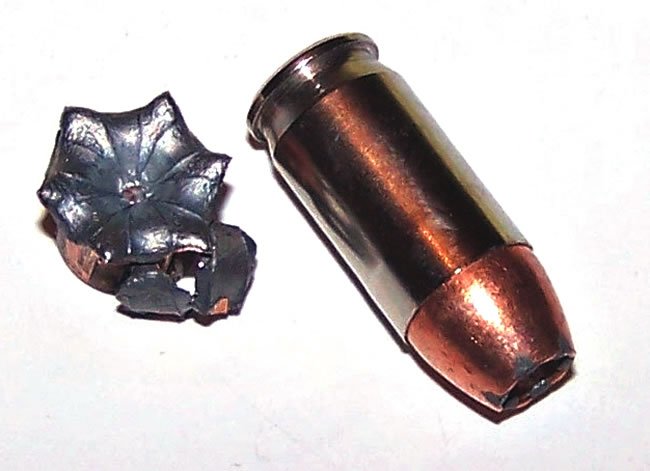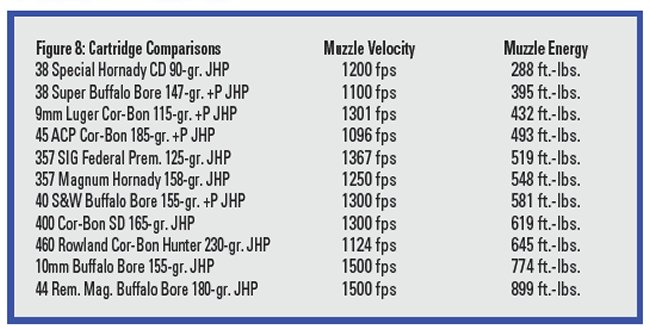
Kel-Tec RFBs Status
For several months, Gun Tests magazine advertised in the Coming Up In Gun Tests column an upcoming test on the Kel-Tec RFB 7.62×51 NATO bullpup rifle. I now notice that gun test is no longer listed. Are you ever going to perform a test on the Kel-Tec RFB?
– Milton Schick
Readers Russell Marcus and Bruce Katz also inquired about this. Contributing Editor Austin Miller performed initial testing on the RFB and encountered significant malfunctions with the rifle, which should be covered by the warranty. So weve returned the gun for warranty work, and will report on all of the problems prior to and after it comes back from the factory. Sorry for the delay. – Todd Woodard
Re Gauging 380 ACP Loads:
FMJ May Be the Only Way to
Go, October 2010
Hello Gents: My wife moved from a Kimber Ultra 45 ACP to a SIG Sauer 380 ACP. Your last evaluation of 380 ammo was in 2010,

as near as I can tell. Since the 380 ACP is growing in popularity, and far more ammo choices are available today, are you guys thinking of a 380 bake-off any time soon? SIG touts new SIG ammo on its site, but nothing in the SIG products section shows how to actually buy it.
– Wayne Kilburn
Hey Wayne: Ive got a lot of ammunition-story inventory already in house, so it will be a while. But I have forwarded your note to Bob Campbell for development. Meanwhile, the winners of the October 2010 380 ACP test, Fiocchi FMJ 95-grain No. 380FMJB (a full-metal-jacket bullet) and Speer Gold Dot 90-gr. No. 23606 (jacketed hollowpoint), remain our top picks for self-defense 380 ammo. Thanks for writing. – tw
Re Which Is Better: 9mm
Luger or 45 ACP? Answer: It
Depends, October 2014
Thanks for the great publication as always. I really liked the scientific way you approached the story on ballistic performance of the various 9mm and .45 ACP defense rounds. Im a reloader and I love this nerdy stuff. However, the muzzle energy numbers are wrong on the 40 S&W and 44 Mag loads you listed. If the bullet weight and velocities are correct, the .40 is actually 581.5 foot-pounds and the .44 Mag is a whopping 899.1 foot-pounds. Also, I shoot and reload a lot of 10mm (which I love) and am familiar with the 460 Rowland, though I dont have one. You mention at the end of the article that 10mm eclipses 460 Rowland, depending on loads and I dont think thats correct. Some of the hottest commercially available ammo that Im aware of is from Underwood, and his highest-energy 10mm is 767 foot-pounds (135 grains @ 1600 fps) while even his mildest 460 Rowland comes in at 957 foot-pounds, and the hottest at 1019 foot-pounds (185 grains @ 1575 fps). Dont get me wrong, Im a 10mm fan, but the 460 Rowland is capable of a lot more energy.– Art Tyszka

The calculation errors were mine, not Mr. Ervins. The corrected table appears above. – tw
As one with some experience with (and affection for) 10mm and 460 Rowland handguns, I must disagree with one of your implicit conclusions in the ammunition comparison article. You compared muzzle velocity and energy of a hot 10mm load sold by Buffalo Bore with those of a relatively modest 460 Rowland load offered by Cor-Bon, and implied that, in general, the 10mm cartridge has a higher muzzle energy than the 460 Rowland. Comparing, however, 155-grain 10mm and 230-grain 460 Rowland cartridges produced by Underwood Ammo, which manufactures loads comparable to those of Buffalo Bore, and using Underwoods approximate velocities, the muzzle energy of the 460 Rowland load is more than 200 foot-pounds greater than that of the 10mm equivalent. The difference is significantly greater for 180- to 185-grain loads for the two cartridges. To quibble a bit more, the widely praised 460 Rowland conversion units sold by several companies include a required compensator, which reduces perceived recoil to roughly that of a 1911 45 ACP (albeit at the cost of an inch and a half greater barrel length). And the significant recoil of 10mm handguns can be reduced by Mag-na-porting. As a practical consideration, 10mm and 460 Rowland handguns excel (assuming appropriate bullets) in reliably penetrating automobile bodies, windshields, and other similar barriers, while still retaining effective velocities and bullet form. Indeed, the smaller diameter of the 10mm round improves penetration over that of larger 45-caliber bullets, other matters being equivalent.
– Don Noble
Re Firing Line, October 2014
The good news for you is that I received the October issue yesterday, and Ive already read it cover to cover. Of course, thats bad news for me since Id like another 32 pages! For Mr. Campbell: I enjoyed the Kimber Tactical Pro v. SIG Scorpion article, but have a question about The Scorpion is a rail gun sentence which begins the Our Team Said: section. Google was not helpful directing me to articles about the larger artillery of WWI, atomic cannons, and next-generation naval rifles. What is a rail gun? I have Glocks, a SIG 220, traditional 1911s, and an S&W M&P 45. Are any of these a rail gun? I assume that traditional 1911s are not rail guns.
Thanks for the help.
– Ron Hunsicker
A rail gun was just Bobs shorthand way of saying a railed gun or a gun with a rail, that is, a handgun with an accessory rail molded into the front of the slide, most often found on polymer-frame handguns, but not always. The rail is usually just a cross-slot for a Picatinny rail mount on an accessory, most often a lightweight flashlight, but lasers, too. Sorry that wasnt clear in the story. – tw
In response to Howard Borns comments and questions about the SIG P938, I have an answer for his trigger problems. I purchased a SIG P938 about nine months ago, and when I got it home, I discovered the safety would not work and it had a difficult trigger press. I emailed SIG Sauer about the problems and received a response within hours to ship my pistol to SIG for repairs. I received my pistol from SIG eight days later. They had replaced the safety, upgraded the ejector, and worked on the trigger. The trigger press is very much improved, up to what one would expect from a single-action pistol. I would suggest Mr. Born email SIG Sauer with his complaint and send it back to them for trigger repair. Admittedly, one would expect a new SIG to come out of the box ready to run, but if thats not case, at least they seem willing to make it right without charge and within a reasonable amount of time.
– Gary Matney
We appreciate your insights on this. Were pretty hard on products because we expect them to run correctly, but we realize that any business can make a mistake on the millions of operations it takes to manufacture products accurately. So we agree with you Gary, the willingness to make something right without charge and within a reasonable amount of time is vital to a companys goodwill. – tw
I wish to add some perspective to Mr. Joseph Dickens comment regarding the reliability of revolvers versus semi-autos in your October 2014 edition.
My first duty auto was a U.S. Army Colt Government Model made pre-WWII and rebuilt in an armory, acquired with pre-1960s magazines. It never missed a beat. I still have magazines from the early years of the Vietnam War, with the springs and followers that were in them then, and none has ever malfunctioned. My second was a Browning Hi-Power, circa 1971, and it never missed a beat.
Between 1984 and 2008, I was issued or bought myself SIG 228s, 226s, 229/357 SIGs, 220s, and a 239/357 SIG. My employer bought cheaper and lighter Bersa Thunder autos to replace totally reliable Walther PP and PPKs. None ever malfunctioned. I did see one magazine bottom pop out during training.
In addition to the SIGs, I owned a number of 1911-pattern handguns (mostly Colts), a few early-model Glocks, some S&W and other semi-autos, none of which ever suffered a mechanical malfunction. One nearly-new Springfield magazine failed due to soft lips, but that was it. I owned, used or observed dozens of Beretta 92s, only one of which malfunctioned. For perspective, our professional-military son has been shooting Berettas since he was 12, and observed malfunctions in the desert, due, he felt, to abysmal care.
For Cowboy shooting I had a pair of 44 Magnum Ruger Vaqueros. On one the hammer would jam as it was cocked, causing me to forfeit the stage. To date, we dont know why it does that. I have two Colt SAAs that, despite shooting black-power cartridges, have never hiccupped.
I had an S&W 327 in which the barrel separated from the frame. An S&W 329 crane broke while I was ejecting shells.
Four Taurus 941 revolvers cham-bered in 22 Magnum I bought for our children bound up so hard the cylinders would not rotate after 18 rounds. Two keyholed and one pitched the rear sight the first time it went to the range. I was given a Taurus 431 in 44 Special. The trigger pull was so gritty and stacked so hard it was impossible to hold the gun on target while pulling. The cylinder of a Taurus 44 Mag. would not lock into the frame. The metal of the frame lug was so soft it eroded away, internal parts looked as though they had been worked with a grinding wheel, and the cylinder bolt spring was too weak to function.
A Colt Anaconda I had would bind up as the trigger was pulled and could not be fired double-action. Back to the Colt factory for a tune-up, after which it worked fine.
The most common mechanical malfunction Ive seen with semi-autos is the failure of the slide to lock back after the last round. To me, this is not a failure to shoot, and is no more dangerous than shooting a revolver empty. In both cases, the shooter has to notice and then reload. I have seen some failures to feed, extract or eject, and, after break-in, most were ammo or operator caused. A couple were due to butchersmithing.
Most semi-auto malfunctions I saw were due to faulty ammo or poor shooter technique – not mechanical problems. An equivalent ammo issue Ive seen in revolvers is when the bullets slip forward out of the shell and lock up the cylinder.
Ive owned or been loaned almost 100 revolvers and, with the exceptions noted, they were completely reliable. I know this because I kept records.
So long as I have vetted the gun, I feel safe with either type.
– Jan Gerstner
Delafield, Wisconsin




























